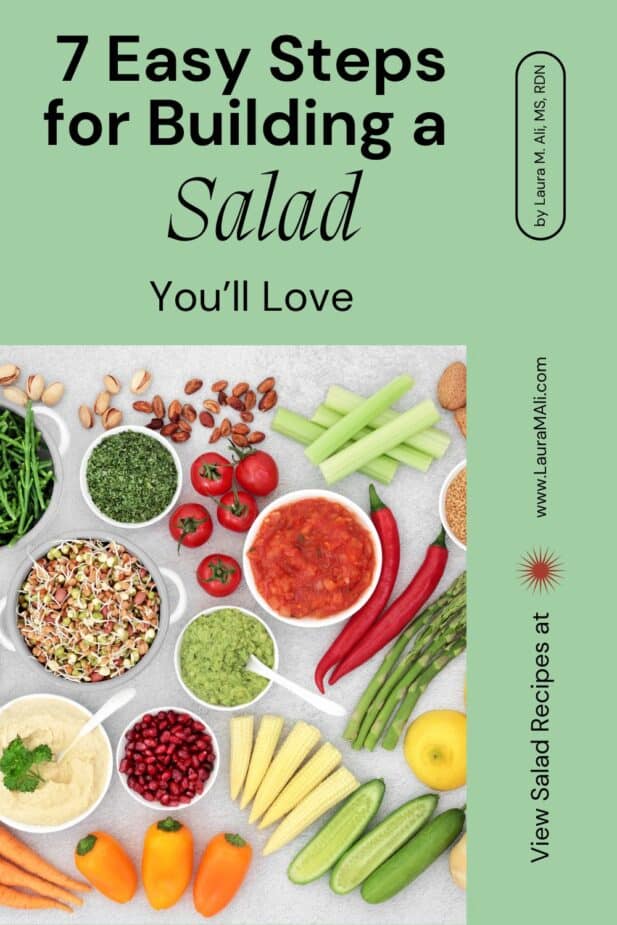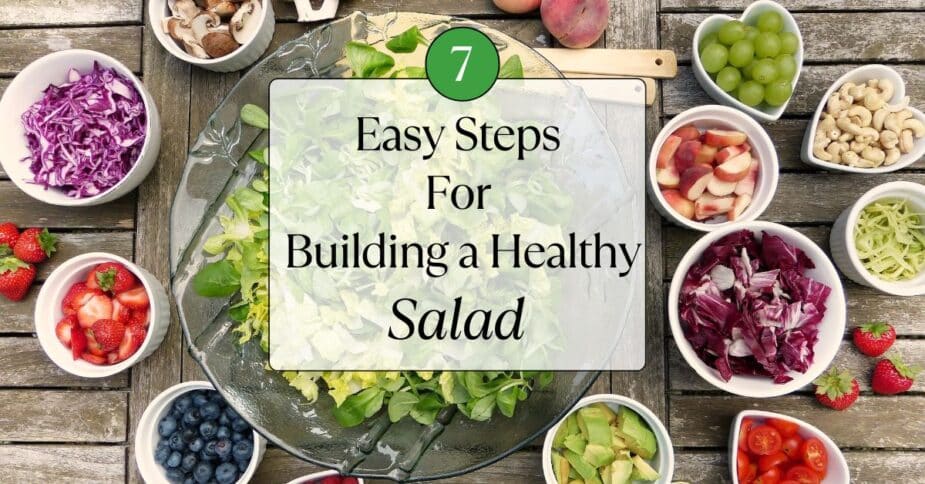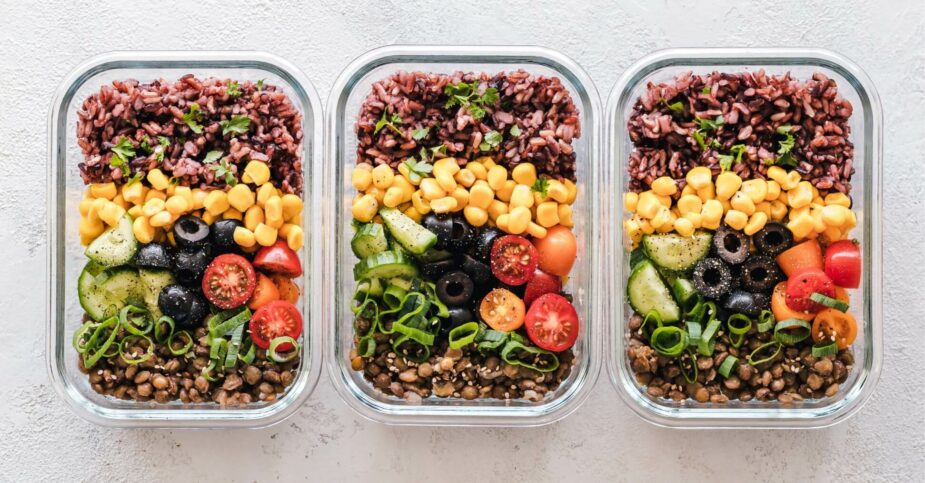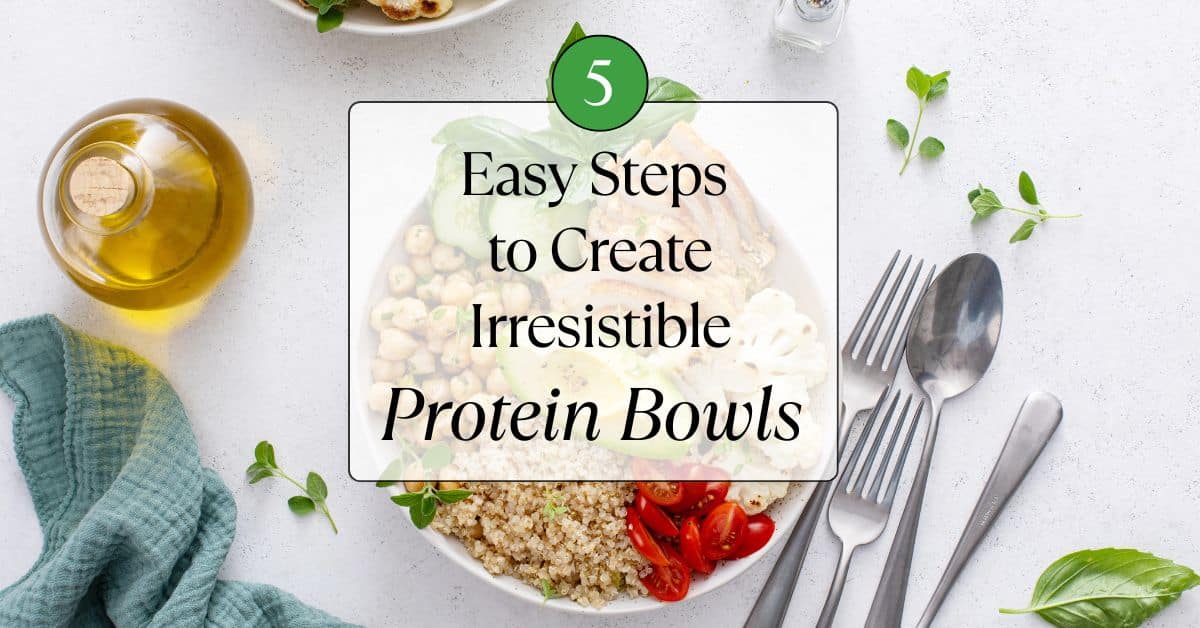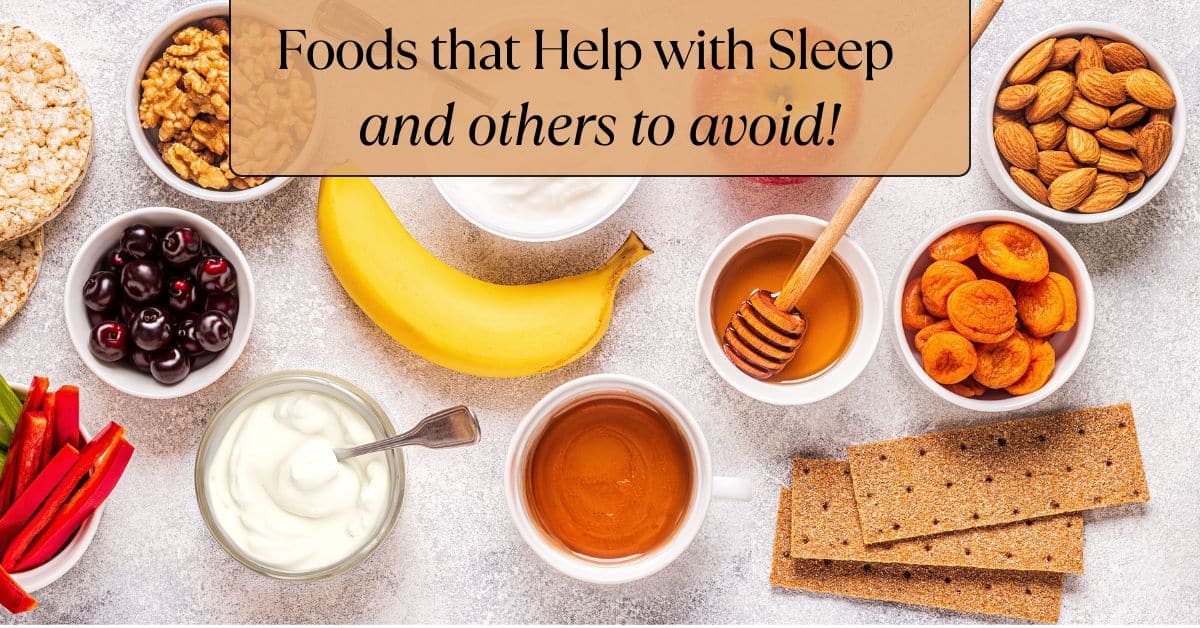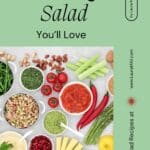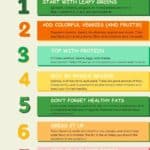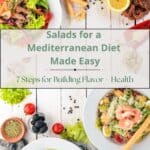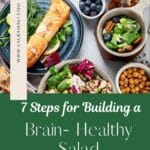Why do restaurant salads always taste so fresh, flavorful, and satisfying, while the ones we toss together at home can feel a little, well, underwhelming? If your weeknight salads aren’t hitting the mark, you’re not alone.
Hi, I’m Laura, a registered dietitian and culinary nutritionist. I’m here to show you how to take your salads from “meh” to mouthwatering with 7 simple steps. You’ll love the vibrant, flavorful, and nourishing salads you can make at home.
Whether you’re trying to use up leftovers, add more veggies to your plate, or make a light lunch that fills you up, these tips will help you build salads that taste just as good, if not better, than what you’d find at a restaurant, and they are packed with nutrition too.
Note: This post contains affiliate links. As an Amazon Associate, I earn a small commission from qualified purchases.
Table of Contents
Building Blocks of a Healthy Salad
Making a salad—whether it’s a light side or the star of your meal—feels like a healthy choice, and it certainly can be. But without a little planning, it’s surprisingly easy to overdo it with high-calorie toppings or skimp on nutrients, turning your good intentions into a bowl that’s more indulgent than nourishing.
A truly healthy salad is more than just a pile of greens with a few cherry tomatoes and a drizzle of oil and vinegar. The best salads are colorful, balanced, and satisfying—and they provide the nutrients your body needs to thrive.
The good news? With the right mix of ingredients, you can build salads that rival anything you’d find at a restaurant. Use the guide below to choose smart combinations that deliver on both taste and nutrition.
How to use this guide: I’ve included the seven key ingredients to making a satisfying salad below. For each ingredient category, I’ve included a suggested serving size for one person. If you’re making salad for more than one person, simply scale up the size!
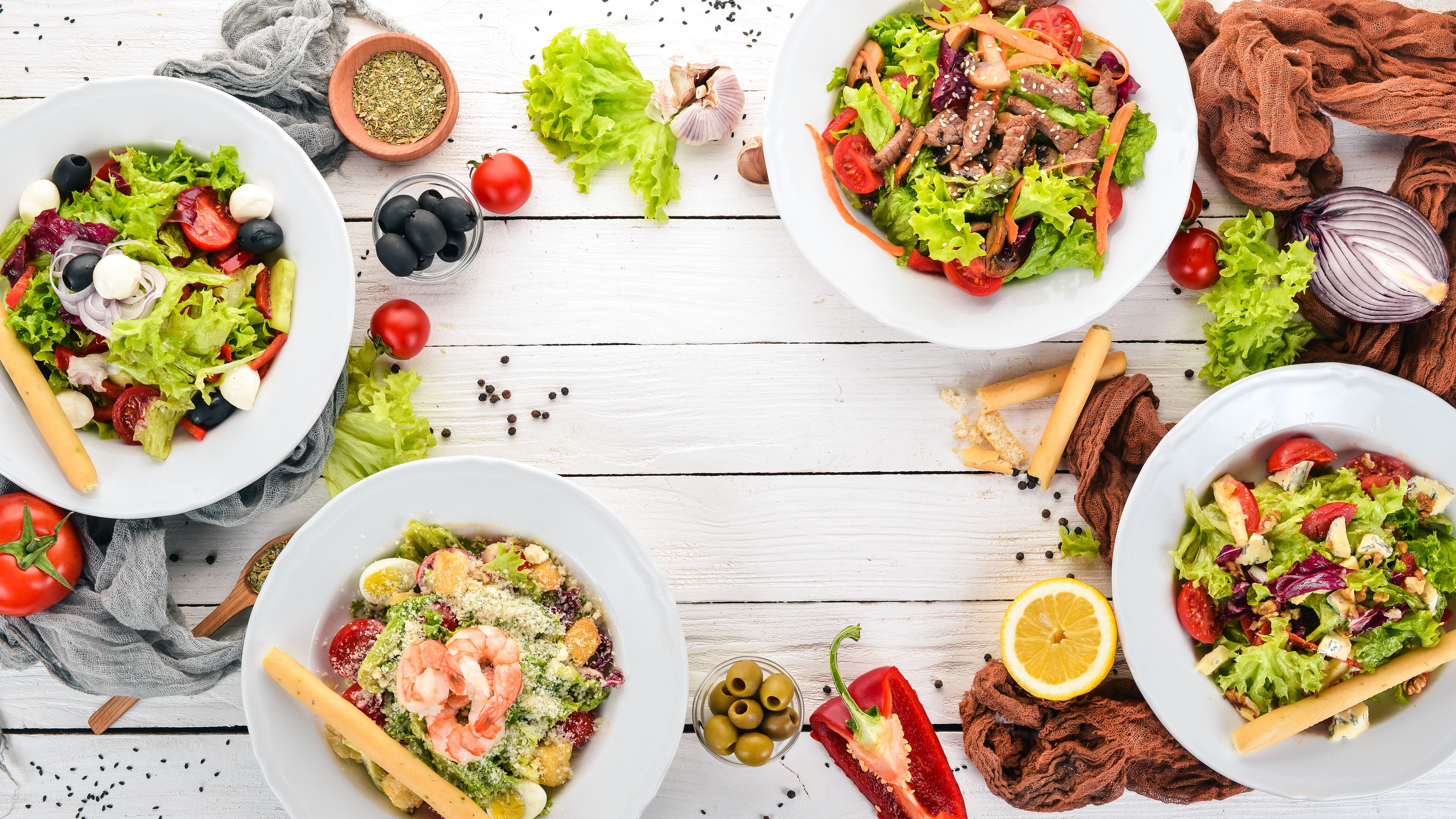
Step 1: Start with a Healthy Base
Start with 1 – 3 cups of greens.
For most salads, starting with a leafy green as your base is the way to go. An exception might be a pasta salad, but even there, lining your plate with some greenery will add color and flavor.
Some of my favorite salad greens are:
- Spring Mix
- Little Gems Greens
- Romaine Lettuce
- Bibb Lettuce
- Red and Green Leaf Lettuce
- Baby Spinach
- Baby Arugula
- Baby Kale
- A blend of “Power Greens”
Buying a head of fresh lettuce will save money, and it’s easy to use on sandwiches and wraps, but it does require extra rinsing and drying. I love my salad spinner to get those leaves really dry. No one wants a soggy salad, so taking this extra step is important.
A quick meal prep tip that saves time and helps those delicate greens last longer: wash them and spin them dry, then wrap them gently in a paper towel and store them in a resealable bag. Place them in the fridge and you’ll have fresh, crisp greens ready to go.
Now, what if you buy a bag of salad or greens in a clamshell and they say they are “triple-washed?” Can you trust that? Yes, you should be able to trust that they are cleaned and ready to use, but if you are concerned, it won’t hurt to give them a good rinse and spin!
Step 2: A Variety of Veggies and Fruit
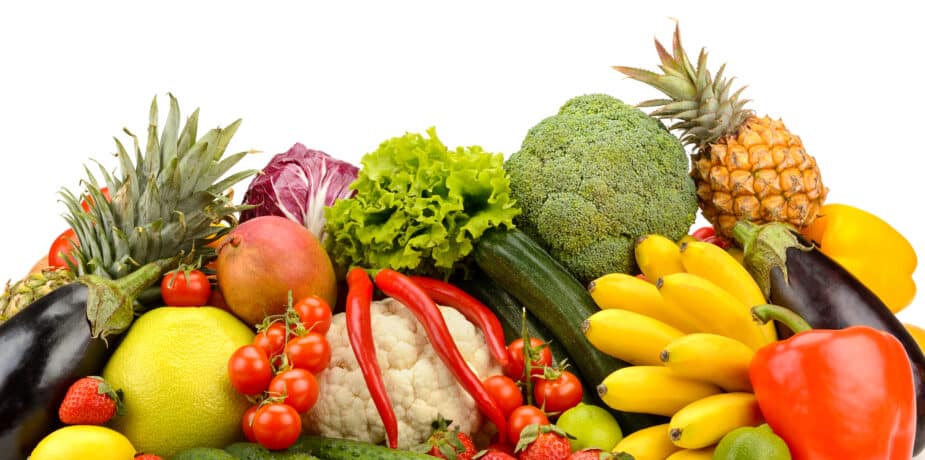
Add ½ cup to 1 cup total of chopped veggies and/or fruit.
Adding a variety of chopped vegetables and fruits will add flavor, texture, and lots of nutrition – and help you get a few extra servings of these healthy foods in your diet!
They are a great way to add variety to your salad, too. Don’t stop just with tomatoes and cucumbers either. Other veggies that work well in a salad are:
- Bell peppers
- Radishes
- Peas and beans
- Carrots
- Green beans
- Summer squash
- Roasted winter squash (butternut, honeynut, delicata)
- Beets
Fruit can also dress it up.
- Blueberries
- Strawberries
- Diced peaches
- Mandarin oranges
- Cherries
- Sliced or diced apples
The sky is the limit! Fruit will add an unexpected burst of sweetness, too.
All of these add fiber, vitamins, antioxidants, and phytochemicals that are important for heart health, brain health, and support our GI tract and immune system.
Step 3: Add Protein
2 to 4 oz is a good portion for a salad
Protein is especially important if the salad is going to be your main meal. Focus on lean proteins, and if you have leftovers from a previous night’s dinner, adding them to your salad is a good way to use them up.
- Roasted chicken
- Pork tenderloin
- Seafood, including canned or pouch tuna and salmon
- Hard-boiled eggs
- Lean beef, like sliced flank steak or flat iron steak
- Cottage cheese? It sure is having a moment.
Cheese is also a nice option, but go easy on it. 1 oz or 2 tablespoons of crumbled cheese is plenty!
- Feta
- Goat cheese
- Queso fresco
- Cojita cheeses
- Fresh mozzarella
Don’t forget about plant-based protein options, too. ½ cup of beans or tofu will add 10 – 15g of protein.
- Chickpeas
- Black beans
- Edamame
- Tofu
Step 4: Whole Grains
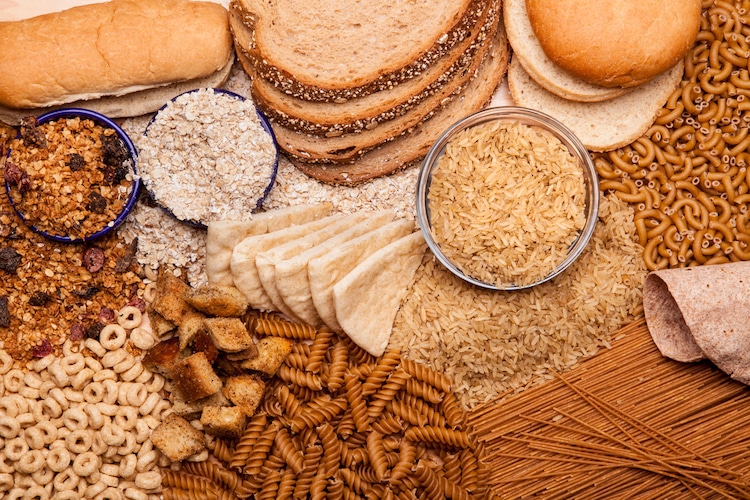
Aim for a ½ cup serving
Along with protein, if you are making a main dish salad, adding some fiber-rich grains adds bulk and makes the salad a balanced meal. Some ideas include:
- Quinoa
- Farro
- Wild rice
- Bulgur wheat
- Whole-grain pasta
These fiber-rich grains are also full of phytochemicals and minerals that help keep your GI tract on track and reduce inflammation.
Step 5: Don’t Forget Healthy Fats
Just a tablespoon or two of nuts and seeds, a ¼ of an avocado, or a few olives is all you need.
Nuts and seeds, avocado, and olives add a good dose of healthy unsaturated fat. These fats help lower inflammation and are tied to lower cholesterol levels and a reduced risk of dementia. You get a lot of bang for your buck with these flavorful ingredients.
While they are full of lots of good things, they do have a lot of calories, so go easy on them.
Step 6: Dress it up
I like making my own dressing, but store-bought is a fine option. Bottled dressings can add flavor variety and are nice to have on hand when you don’t have time to make your own.
Now, if you are buying bottled dressing, you may be tempted to go for the fat-free or reduced-fat dressings, but honestly, I think it is better to use the regular version for a couple of reasons.
First, when companies reduce the fat, they have to add other things to bump up the flavor. While you may think you are saving on calories, you may be trading those calories for more sodium and sugar.
Second, the fat in the dressing is helpful! Yup, you heard me right. The fat found in salad dressing (or nuts or avocado) is good for you and can help your body absorb those healthy antioxidants from the other ingredients! That beta-carotene that makes carrots orange? Fat-soluble!
And a little goes a long way – Toss your salad with a tablespoon or two of dressing.
If you’d like to play with making your own dressings, you can find some of my favorites here.
Step 7: Bump up the Flavor
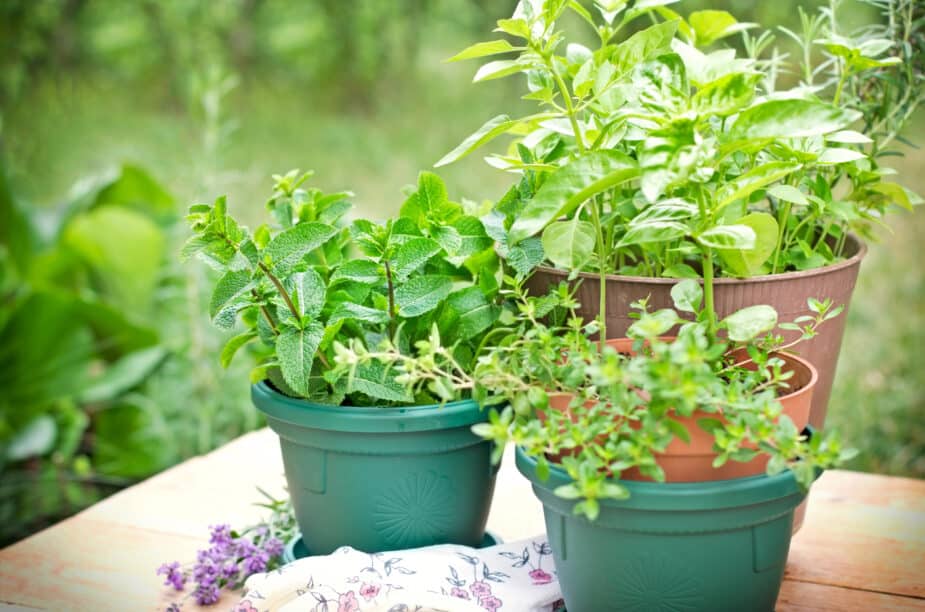
One final touch will make your salad sing! If you’ve never added fresh herbs like basil, dill, mint, or parsley, or a handful of microgreens to a salad, you must give it a try. These fresh little greens add an unexpected burst of flavor and some nutrition, too.
Other ingredients that are delicious flavor boosters are pickled onions and peppers, roasted chickpeas, roasted veggies, or even a dash of “everything but the bagel” spice.
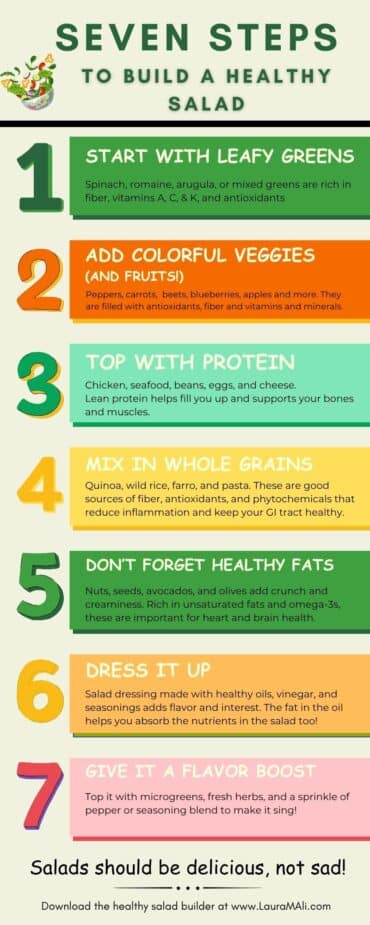
How to Build Your Salad
Now that you have the steps and ingredients you need to build your salad, let’s talk about the how-tos.
Shop/Stock up
Keep a list of your favorite salad ingredients and build them into your weekly grocery shopping routine. Things like baby spinach, bell peppers, and cherry tomatoes are things you pick up every week. Then add various other veggies and fruits based on what is in season.
It’s also helpful to stock your pantry with staples that you can add to your salads as you want. Nuts, a variety of dried beans, canned artichokes, olives, jars of roasted peppers, or sundried tomatoes, and canned or pouch tuna and salmon are things you can keep in your pantry so they are always available.
Prep Ahead
Getting some of your fresh produce prepped and ready can be a lifesaver at meal time. Wash your greens and store them rolled up in paper towels, slice veggies, and cook grains.
You can cook and prep some protein options as well, like roasting chicken or salmon, or grilling a steak, and slicing it ahead also works well.
Store ingredients separately in containers so you can quickly assemble different combinations throughout the week.
Quick tip: Keep your greens whole until you are ready to use them. Tear or chop them right before serving to keep them fresh and crisp. Tearing or chopping exposes more of the surface to oxygen, which can cause them to turn brown and spoil faster.
Set Up a Salad Station
Now that your ingredients are prepped and organized, you can easily set up a “salad station” or put ingredient bowls on the table for everyone to select the ingredients they want in their salad.
Salad stations are great for families or a fun option for entertaining, too.
Make Some Grab-and-Go Options
Jar salads have been a trend for a while, and they are great when you need a grab-and-go lunch or dinner.
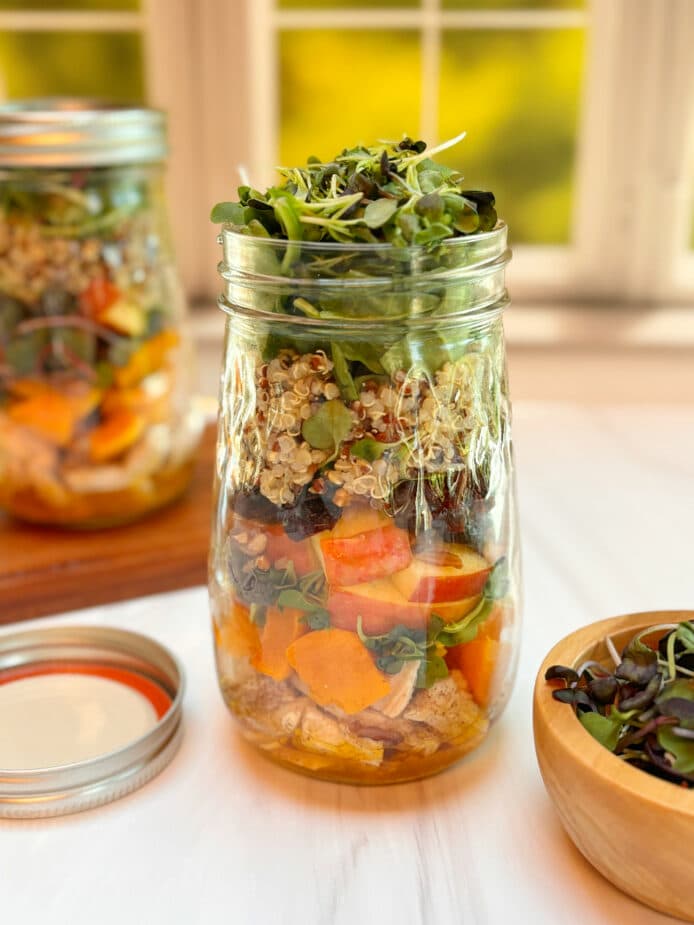
The trick with a jar salad is in the layering. Place the dressing at the bottom of the jar so it doesn’t wilt the tender veggies. Then add your protein, followed by hearty vegetables, grains, nuts, and/or fruit. Place your greens on top.
When you are ready to enjoy it, hold the jar over a plate or bowl and gently tap it for the ingredients to fall out. Greens will be on the bottom, with the other ingredients and dressing falling out on top. A perfect salad!
Bento boxes also work well, allowing you to hold each of your ingredients in separate compartments. You can assemble the salad when you are ready and dress it right before eating.
Keep it Interesting
Rotate your dressings, toppings, and seasonal ingredients to keep things fresh. In the spring, try new greens like watercress or baby arugula and add fresh berries. In the fall, roasted winter squash, apples, and cranberries are great to add.
Try a new nut, cheese, or fruit each week, or make a “theme salad” like Mediterranean, Southwest, or harvest-style.
Download my Easy Salad Builder Guide and try different combinations of ingredients for endless salad ideas.
If you want some “ready to go” recipes, check out my favorite salad recipes here, and if you need inspiration for some delicious homemade salad dressings, I’ve got you covered, too.
There are so many fun ways you can dress up a salad and keep your meals exciting, delicious, and fun.
Pin This to Remember this Post
